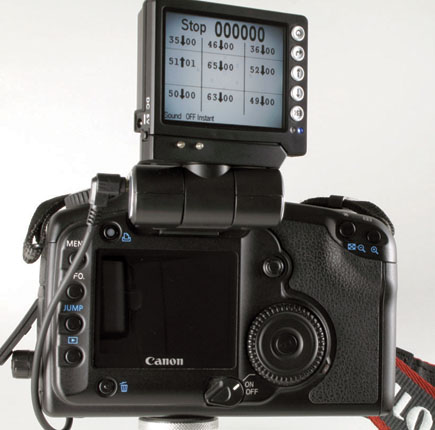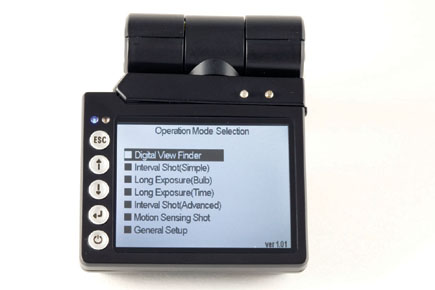ZigView S2; Add Live View, Intervalometer, And Motion Sensing To Your D-SLR With This Compact Device
Granted, when hand holding my Canon EOS 5D D-SLR, I prefer to use the optical
viewfinder for the utmost stability. But there are many times when I'd
be just as happy to view the subject on the LCD--except, of course, that
this camera, unlike newer models, lacks a live view display.
Well, I've found just the device that gives my 5D that capability (calling
it a Digital Viewfinder), and then some. The ZigView S2 from Seculine (and available
through Argraph) is one of the cleverest gadgets to come down the pike in a
very long time. It offers an integrated intervalometer to help you capture a
stream of events as stills and motion sensing to help with those fleeting moments
that, till now, may have eluded capture. And there are a couple of other features
you may find useful as well.
 |
Some Assembly Required
You can't simply slide the ZigView onto the camera eyepiece right away.
First, you order the ZigView with the correct eyepiece adapter for your D-SLR
(from a choice of three designed to fit most popular models). Then you have
to attach that adapter to the main body of the device with the aid of four tiny
screws. The ZigView comes with a special screwdriver and extra screws, because
they are easy to lose--but once attached, it should remain that way. Then
slide off the accessory eyecup from the camera eyepiece and slide this over
the eyepiece in its stead.
There is one more thing. You may find that the data area in the camera viewfinder
is blocked by this new eyepiece. There are three spacers designed to correct
this problem. After wrangling those tiny screws through a spacer, I decided
I'd do better without it. The problem is that the ZigView display seems
to shrink the image, so the data was nearly impossible to read. I preferred
instead to simply refer to the LCD panel on top of the camera to verify all
my data. And I chose to fill the ZigView display with the image by stretching
it out all the way to the edges (a function of the general setup). Somewhere
along the way, you'll need to recharge the lithium ion battery. One full
charge is enough for at least an hour and a half of continued use.
 |
|
 |
|
|
Live View Monitor & Interface
When you're walking around, hold the camera away from your chest to prevent
the ZigView from becoming dislodged after a bump or two against your body. I
initially opted to view the monitor image in color. That, I later learned, works
better with
close-ups and is less successful where there's lots of detail in the scene,
so I opted for the Black and White Viewing mode at these times. What I really
would have liked is a punchier screen. And maybe a hood to shade it. (Part of
the problem appears to be the fact that you're looking through two finders--this
plus the camera's.)
The display monitor flips up or down and swivels. There is some restriction
to the movement, so be methodical to prevent damage. If the image appears upside
down, briefly hit the Power button alongside the display to correct it. At the
opposite end of this row of buttons is an Escape button. In between are Up/Down
Cursor/Data buttons and an Enter/Execute button. The Enter/Execute button is
the one used to initiate a process, such as to begin motion sensing. In Live
View mode, repeatedly holding down the Enter/Execute key will cycle through
10 different Compositional Style modes, which can be a real boost for more dynamic
picture-making. In other modes, it opens an on-screen menu with a host of parameters
that give you ultimate control over practically every nuance in this device.
For playback, you'll have to resort to the camera's monitor.
The buttons can sometimes be problematical and unresponsive, and I occasionally
found myself repeatedly hitting a button until something happened. Perhaps there's
a trick to it that I didn't get. Still, I'd like them to be more
responsive.
 |
|
 |
|
|
- Log in or register to post comments

































